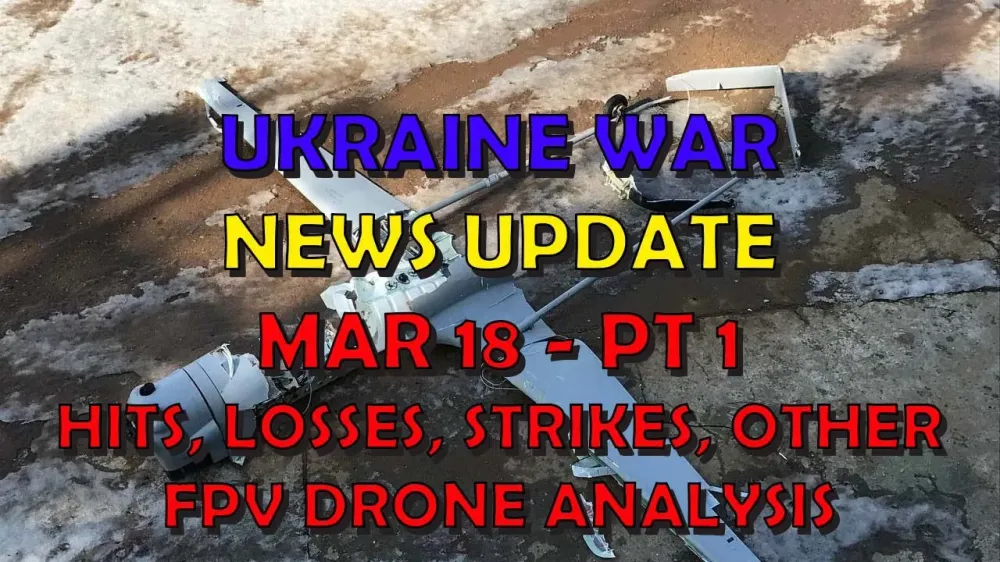Ukraine War Update NEWS: Pt 1 - Overnight & Other News
Table of Contents 📖
"They are going to be dipping back into the BMP-1s that they have to do really heavy work on. Anyway, just a theory."
Hello Team
🎦 00:00-01:43⏩
Jonathan welcomes everyone to another video. He apologises for the video being late, blaming a system update. Jonathan thanks everyone for their incredible generosity during last night's livestream, which raised money for armoured medevac vehicles. He addresses an issue with the live stream that resulted in several regular commenters being blocked by a moderator, stating that he does not know what happened but is working to resolve it.
Return to top⤴️
🪦 DISCLAIMER FOR GENERAL STAFF LOSSES DATA
- These are real people with real lives and real families who love them. Don’t let the numbers sap your humanity.
- These numbers probably aren’t accurate but they’re the best we have and we don’t need them to be accurate to be indicative of patterns of activity.
- All losses are estimates. Losses cannot be counted with accuracy because of the conditions on the ground.
- Both sides would see it to be of their advantage to minimize their own losses maximize the other side’s losses.
- Neither side releases their losses but we have enough transparency from the Ukrainian side to have confidence in they are indicative.
- Personnel losses are hard to count. If a soldier gets injured, heals up, and returns to the front line only to get injured again, is that one loss or two? Also, how to deal with losses from PMC’s or soldiers fighting with RF from occupied territories?
- Equipment losses are hard to count. If an AA complex involves several parts and one part gets disabled, is that a loss, or a fraction of a loss? If a tank gets disabled, repaired, back into the fight, then disabled again, is that one lost tank or two?
- All recorded losses are vulnerable to multiple reporting. We have already seen numerous cases of multiple drones in the air reporting the same loss from different angles as multiple engagements.
- Losses are not always reported on the same day they occurred. It is frequent that drone losses are reported at least 24 hours after other terrestrial equipment losses. Certain losses may not be reported for days or weeks for military intelligence reasons.
Ukrainian General Staff figures for 17/03/2024
🎦 01:43-03:05⏩
Jonathan reports that according to the Ukrainian General Staff, Russian losses over the past 24 hours included 810 personnel, 19 tanks, 17 armoured personnel vehicles (APVs), 34 artillery systems, 68 vehicles and fuel tanks, and eight pieces of special equipment. He notes that these are high numbers, particularly in certain categories.
Return to top⤴️
Confirmed Ukrainian Losses for 17/03/2024
🎦 03:05-05:34⏩
Jonathan discusses visually confirmed Ukrainian equipment losses, which include an Mi-24 helicopter shot down near the northern border, a Batu engineering vehicle, a drone, two boats, a couple of tanks, and some M113s. He notes that most of these are low-value items, except for the helicopter and the Batu. Jonathan highlights that the loss ratio between Russian and Ukrainian forces is estimated to be around 3:1, favouring the Ukrainians.
Return to top⤴️
The Mi-8 Helicopter Incident in Transnistria
🎦 05:34-06:56⏩
Jonathan talks about the alleged Ukrainian attack on an Mi-8 helicopter in Transnistria, questioning the logic behind the incident. He points out that the targeted helicopter had been stationary for 20 years and held little tactical value, making it an unlikely target for Ukrainian forces. He finds it suspicious that the incident was captured from multiple angles with high-definition cameras and quickly disseminated on social media. Given these factors, Jonathan suspects that the attack might have been a false flag operation orchestrated by the Russians to escalate tensions in Transnistria and justify further actions in the region.
Return to top⤴️
Confirmed Russian Losses
🎦 06:56-07:15⏩
Jonathan references reports from Ukraine's border guards, indicating that six Russian soldiers were killed while attempting to cross into the Chernihiv region. He attributes their deaths to a minefield encounter followed by a mortar attack.
Return to top⤴️
Russian Armoured Fighting Vehicles (AFVs) in Storage: A Deep Dive
🎦 07:15-18:28⏩
Jonathan delves into an analysis of Russian AFV storage, specifically focusing on BMPs. He highlights the substantial number of BMPs in Russian storage before the war, estimated at 5,766, citing research by two individuals. He emphasises that this figure excludes vehicles actively used by the Russian army and other government entities. Jonathan explains that these stockpiles enabled Russia to compensate for equipment losses during the initial stages of the war by drawing from these reserves. He describes a tiered system where readily deployable vehicles are utilised first, followed by those requiring refurbishment and, lastly, those that are cannibalised for parts. Jonathan cites satellite imagery analysis by 'John P', revealing a significant drop in stored BMPs at various bases across Russia. However, he notes that one base surprisingly showed an increase in stored BMPs, attributing it to a possible relocation of vehicles from garages to open storage. Jonathan argues that the depletion of BMP-2s has forced Russia to increasingly rely on older BMP-1s, which necessitate extensive refurbishment. He acknowledges the lack of recent satellite imagery, making it difficult to accurately assess the current state of Russian AFV reserves. Despite the challenges in obtaining up-to-date information, Jonathan contends that Russia possesses sufficient BMP-1s to sustain its war effort for a considerable period. He estimates that Russia can continue the war for another 1.5 to 2.5 years based on its current BMP reserves, assuming a consistent rate of refurbishment and external factors.
Return to top⤴️
Update on First Person View (FPV) Drone Usage
🎦 18:28-29:23⏩
Jonathan discusses recent data on first-person view (FPV) drone usage, highlighting Ukraine's significant advantage in this domain, particularly in striking infantry and vehicles. He references data from 'Toczny', indicating that Ukrainian forces have significantly surpassed Russian capabilities in FPV drone strikes on infantry, surpassing Russian figures by more than double. Jonathan attributes this success to increased Ukrainian drone procurement, both domestically and from international sources, alongside their effective deployment strategies. He observes that while Russia had an initial advantage in night vision-equipped FPV drones, Ukraine has closed the gap and even surpassed Russian strike numbers in recent months, indicating a potential turning point in this area. Jonathan points out that Ukraine has strategically focused on targeting Russian trucks and logistics vehicles with their FPV drones, aiming to disrupt Russian supply lines and hinder their war effort.
Return to top⤴️
Russian Logistics Problems - Derailment
🎦 29:23-30:03⏩
Jonathan reports a freight train derailment in Russia's Arma region, involving 20 wagons. The incident occurred after a collision with a passenger car, leading to the suspension of train traffic between Gorelia and Bombska. Jonathan suggests that this derailment will likely cause significant logistical challenges for the Russians, further straining their supply lines.
Return to top⤴️
Overnight Drone and Missile Attacks 17/03 - 18/03/2024
🎦 30:03-35:02⏩
Jonathan shifts his focus to overnight drone and missile strikes, reporting that Ukrainian forces intercepted 17 out of 22 drones launched by Russia. However, he expresses concern over the five drones that penetrated Ukrainian air defences, the targets of which remain unknown. He further notes Russian missile strikes on Kharkiv and Sumy regions, employing S-300, S-400, and Kh-59 missiles. Jonathan highlights a concerning trend of Russian forces targeting civilian infrastructure in their missile attacks, citing the recent double-tap strike on Mykolaiv, which resulted in civilian casualties. He contrasts this approach with Ukraine's more strategic targeting of Russian oil refineries and military assets. Jonathan questions whether Russia's focus on civilian infrastructure stems from a lack of intelligence on military targets or a deliberate strategy to demoralise the Ukrainian population. He argues that regardless of the reasoning, Russia's approach has proven ineffective in breaking the Ukrainian spirit. Moreover, it has depleted their missile stockpiles, limiting their ability to engage critical military targets. Jonathan speculates that the upcoming elections in Russia may have influenced both sides' actions, suggesting a potential decrease in attacks following the election period.
Return to top⤴️
Analysis of Recent Russian Election
🎦 35:02-37:43⏩
Jonathan transitions to discussing the recent Russian elections, where Vladimir Putin secured a dubious 88% of the vote. He highlights a protest movement called 'Noon Against Putin', which involved coordinated demonstrations at Russian embassies and even within Moscow. Jonathan explains that protesters aimed to visually represent their dissent against Putin's rule by queuing up to vote at noon. He acknowledges that these protests are unlikely to impact the election results but represent a growing discontent among some Russians. Jonathan further notes that Putin unusually mentioned Alexei Navalny by name during his victory speech, alluding to his alleged death without explicitly confirming it or assigning blame. He analyses a New York Times article that outlines five key takeaways from Putin's orchestrated victory. The report suggests that while Putin's win was expected, the scale of his fabricated victory exceeded expectations. Furthermore, it highlights the Kremlin's failure to project a unified national image. The article predicts that Putin will exploit this fraudulent mandate to justify continuing the war in Ukraine and further consolidate his control, likely through increased military mobilisation and internal repression.
Return to top⤴️
Effectiveness of Ukrainian Drone Strikes on Russian Oil Refineries
🎦 37:43-39:40⏩
Jonathan circles back to the topic of drone strikes on Russian oil refineries, providing a comprehensive analysis of their effectiveness. He cites data from 'Anton Gerashenko', indicating that since the beginning of the year, there have been 15 drone attacks targeting 13 oil refineries across nine regions in Russia. These attacks have resulted in significant damage to eight refineries, impacting Russia's oil production capacity. Jonathan reports that these attacks have affected 46 million tons of refining capacity annually, equivalent to 14% of Russia's total refining capacity and 17% of oil refined in 2023, dealing a considerable blow to Russia's economy. He reveals that according to 'The Insider', Ukrainian forces may target the Ryzan and Samara refineries next due to their strategic importance in supplying the Russian military. Jonathan cites reports from a Russian Telegram channel claiming that recent drone attacks on the Slavyansk oil refinery in Krasnodar caused substantial damage to crucial atmospheric and vacuum distillation units, impacting both the quantity and quality of oil refined. In response to these attacks, Russian propagandists have shifted their rhetoric, urging businesses to bolster their defences against drone attacks, even threatening the nationalisation of refineries failing to adequately protect themselves. Jonathan concludes by reiterating Russia's vulnerability in protecting its vast infrastructure, particularly its oil refineries, due to the sheer size of the country and the limited availability of air defence systems.
Return to top⤴️
Wrap up
🎦 39:40-39:48⏩
Jonathan thanks viewers for watching and encourages them to like, subscribe, and share the video. He signs off with a "take care".
Return to top⤴️




